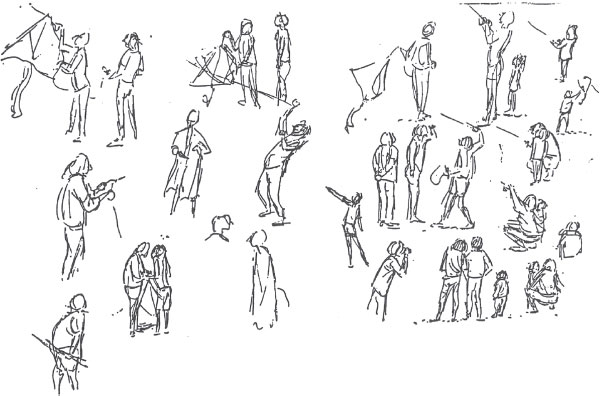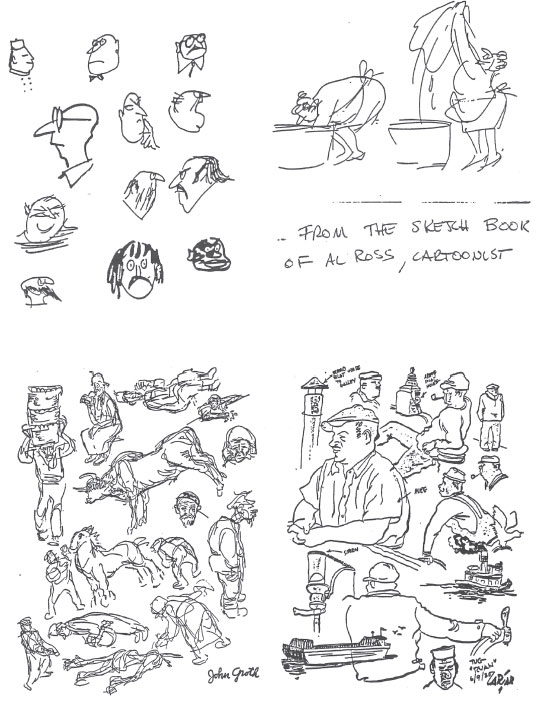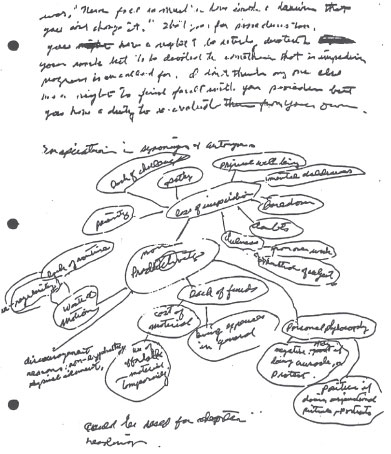If you haven’t been a note taker — become one. Hundreds of potentially fertile ideas have drifted through your consciousness and have spun out into oblivion to be lost forever. You often hear or see things that, like a potent horseradish sauce clearing the sinuses, sparks a clear vision of some illusive point, perhaps some clearer way to draw a wrinkle or some better way to draw hands or knees. It seems so clear at the time there seems to be no reason to make a note of it. Many, perhaps dozens of ideas have bombarded your sensitive receptors during the day (and night), the overload adjusting itself in favor of a few of the most impressive messages, not always the most useful. So write them down, or sketch them, they may prove very valuable at a later date. A seasoned note taker will often hear a seemingly dull bit of information and, either on the spot or later, translate it into a meaningful bit of wisdom. Once down in writing or in drawing form it can be like a seed planted in fertile soil, burgeoning into growth when given the proper inducement.
Taking notes, like sketching, sharpens the mind, hones it into a more sensitive and receptive instrument, more ready when needed than one that is allowed to “flow with the tide.” It can be the difference between being a reactor or an actor. The reactor drifts along awaiting opportunities from others before making a move. The actor checks his notes and comes up with a positive move of his own. Most, if not all, artists, composers, authors, scientists, etc., have been and are avid note takers and sketchers.
A three-ring, loose-leaf notebook with unlined paper is ideal for writing, sketching, and storing notes in. It may be too large to carry with you everywhere, so augment it with a small note pad that will fit into a pocket or purse. The notes taken in the small pad can be removed and taped or glued into the larger book. Record the source, or initial and date those of your own origin. It will be a great focus of learning and a pleasurable hobby, and will help keep your mind alert for new ideas and to new vistas of creative thinking.
Here’s how Robert Kaupelis puts it in his book, Experimental Drawing:
I suggest that you wed yourself so thoroughly to your sketch book that it almost becomes a physical extension of yourself. And now what you must do is draw and draw and draw and look at drawings and draw and draw and draw and look at drawings and draw…
In Cartooning Fundamentals by Al Ross, he says:
Finally, I cannot stress too strongly the value of carrying a sketch book at all times. In it you can record notes and ideas and, above all, a continuous record of your development as an artist or cartoonist.
Your note/sketch book can and should contain both writing and sketching. Memories are often useful in creative work. Present day experiences are worthy of recording, saved, and savored. Jot down only the pertinent details. Sketch scenes and expressions making comments beneath the sketches. Describe people you know and meet. Don’t correct your impressions later; it’s better to write or draw new ones. Develop your senses by becoming aware of them. Record them in a straightforward manner and/or caricature them to some humorous extreme. What you will be doing is sharpening your sensibilities, increasing your susceptibility to impressions, and refining your ability to perceive and to transpose them into graphic form. Soon you will find yourself exploring your world for impressions and the recording of them will buoy you up mentally, physically, and spiritually. Remember my formula for this: impression – expression – depression. So become a note taker, start collecting things — not through one ear or eye and out the other, but graphically, through your fingers with which you have chosen to express yourself. Copy words, phrases, bits of articles, drawings, paintings, anything that awakens a spark in you.
That great teacher Robert Henri (The Art Spirit) said:
He (the artist) moves through life as he finds it, not passing negligently the things he loves, but stopping to know them, and to note them down in the shorthand of his sketch book…He is looking for what he loves, he tries to capture it. It’s found anywhere, everywhere. Those who are not hunters do not see these things. The hunter is learning to see and to understand — to enjoy.
One more quote and then we’ll take a break with some examples of sketchbooks.
From the book, Cartooning For Everybody, by Lawrence Lariar, comes this excerpt:
Sketching is sketching. It involves a model, usually, whether the model is a buxom nude or an old tomato can. It is copying, after a fashion. The cartoonist, when he sketches, is going through a process of study. He concentrates upon the model, plumbs its movement, bulk, and outline. Then he sets it down, remembering that he wants only the spirit — the guts of the thing he’s after. He puts into his drawing all his experiments. He isn’t concerned with anatomy, chiaroscuro, or the symmetry of “flowing line.” There’s nothing highbrow about his approach to the sketchpad. He is drawing because he likes to draw! All types of sketching benefit the artist. Never stop sketching! Sketch at home, in the subway, on picnics, in art school or in bed. But SKETCH!

While sketching a boxing match on TV I cat-ch (pun intended) a disinterested non-viewer. Quite a switch from the violence on the television screen.

Arming yourself with a sketchbook will put you at the ready when opportunities present themselves. One day while searching for driftwood and shells (for my driftwood mobiles) and seaweed (for my wife’s basket making), I ran into this group of kite flyers at the beach.

A page from the artists, Lariar and Groth. Styles and subject matter differ, but the benefits and rewards are the same. For the artist or cartoonist there is more realism here than if photographs had been taken.
A good way to take notes or to gather your thoughts on any subject is to state the problem or subject at the center and circle it. Then as related thoughts come or as you gather research, attach them to the center by a line and into groups that are more closely related. It is a wonderful means of focusing the mind.

I was working on an inspirational book for artists who find themselves in the doldrums. These suggestions for a title could have been jotted down in a restaurant or while driving.

They were done inside a cardboard template with the eyes closed. The borders were added later. Good exercise!

These were done with the eyes open.

